-
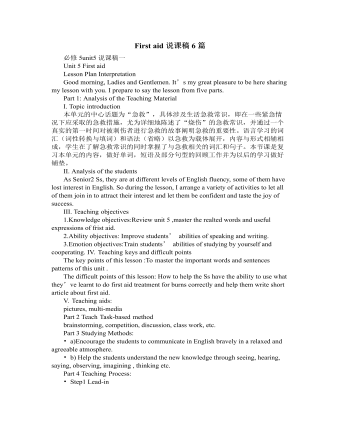
人教版高中英语必修5First aid说课稿6篇
In this class, I have 3 teaching aims, that is, knowledge aims, ability aims and emotion aims.1) Knowledge-Teach students new words and expressions, such as temporary, bleed,sprain choke, first aid, fall ill and so on.-Enable students to have a better understanding for some basic knowledge of first aid.2) Ability-Train students’ speaking, reading and writing abilities by different teaching activities, such as skimming, comprehending, team work, role play, retelling and writing.-Develop students’ reading strategy on how to move general idea to specific information.3) Emotion-Promote students’ awareness of giving first aid.- Cultivate students’ creativities.Then let’s come to my teaching methods and activities.III. Teaching methods and activities:To achieve different teaching aims, various kinds of teaching methods and activities will be adopted throughout this period, such as TBL (task-based learning), skimming, team work, brainstorm and others, which can offer students opportunities to fulfill tasks in which they can use language to achieve a specific outcome.IV. Teaching aids:Computer and blackboardV. Teaching important points:1) Make students have a clear mind for the structure of the text.2) Help students understand the theme of the text.VI. Teaching difficulties:1) So many new words may affect students’ understanding.2) How to get students to know about the functions of the skin and thecauses, characteristics and treatments for different degree burns,and the knowledge about giving first aid. VII. Blackboard design:
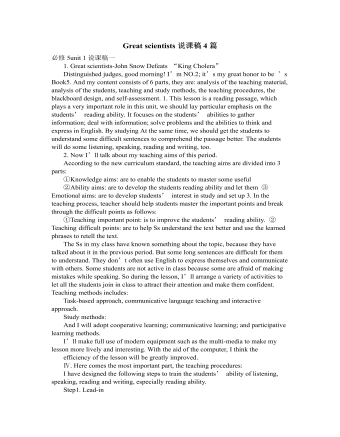
人教版高中英语必修5Great scientists说课稿4篇
通过写文章梗概,培养学生综合运用语言的能力,学习用恰当的英语描述科学家的故事。这是本课的教学难点。教师可以使用完形填空的方式来帮助学生整理语篇,从而来降低难度。本课的教学重点的突破方法是:在阅读前,让学生初步了解得出科学观点所需要的基本程序,从而轻松而自然地导入文章的阅读;在阅读过程中,由易到难设计快速阅读和精读的问题,层层推进各种阅读活动,让学生对阅读内容从整体感知到细节理解,最后深层读懂整篇文章,同时加强阅读策略的指导,让每个学生都主动参与课堂教学活动,最终达到提高阅读能力的目的。Step 4 Post-readingGroup Activities四人小组共同合作,在老师的适当指导下,就以下2个问题展开讨论,让学生就所知、所学、所感和所想融入话题,然后抽若干同学代表作小组发言。1. What do you think about John Snow, and what should we learn from him?2. Cholera was 19th century disease, which two diseases are similar to cholera today? Why?

人教版高中英语必修5Life in the Future说课稿5篇
Good afternoon, everyone. It’s my great pleasure to be here sharing my lesson with you. The content of my lesson is Senior English for China Book5 Unit 3 Life in the Future. I’ll be ready to begin this lesson from six parts: Analysis of the teaching material, Analysis of the students, Teaching aims and important and difficult points, Teaching methods and aids, Teaching procedures, and Blackboard design. First, let me talk about the teaching material.Part 1 Analysis of the Teaching Material:This unit is about what human beings’ life will be like in about one thousand years. By studying of this unit, we’ll Enable the students to know the changes in humans’ life and some new inventions bringing about the change and develop the interest in science. This lesson plays an important part in the English teaching in this unit. This is an important lesson in Book Five. From this lesson, it starts asking the Ss to grasp contents of each passage. Therefore, this lesson is in the important position of the teaching material. If the Ss can learn it well, it will be helpful to make the Ss learn the rest of this unit.Part 2 Analysis of the SsAs Senior2 Ss, they are at different levels of English fluency, some of them have lost interest in English. So during the lesson, I arrange a variety of activities to let all of them join in to attract their interest and let them be confident and taste the joy of success.
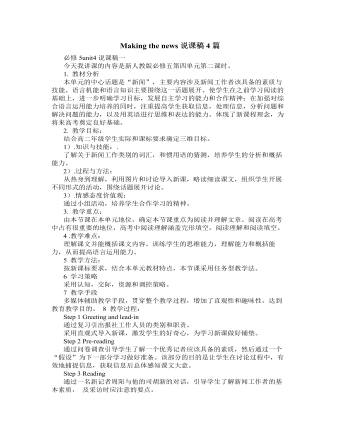
人教版高中英语必修5Making the news说课稿4篇
今天我们来介绍一下必修五第四单元的授课方式。这个单元的题目是Making the news。应该是学生比较感兴趣的话题,学生往往对新闻工作充满好奇,所以我们可以利用这个机会多设计一些师生互动和学生互动,来激发起学习的积极性,提高学习效率。同时我们可以利用这个单元不仅帮助学生掌握语言知识,培养语言能力,同时让其了解新闻工作的重要性,培养起社会智能感。这个单元分为六个课时,它的教学目标是这样的:语言目标是掌握词汇表中的常用单词和短语,掌握倒装句的一些基本用法。 技能目标是能初步掌握约会的基本句型并在真实的场景下正确运用。新闻报道类文章的写作技能。采访的基本规范和沟通技能。情感目标是对新闻报道的客观性和真实性有更好的理解。对新闻记者的职业有更深入的了解,并能体会其工作的重要性。下面我们来介绍一下第一课时的授课方式,第一课的教学目标是这样的第一课时的教学目标语言目标:单词:Occupation, journalist, editor, photographer, curious, personality, enthusiasm
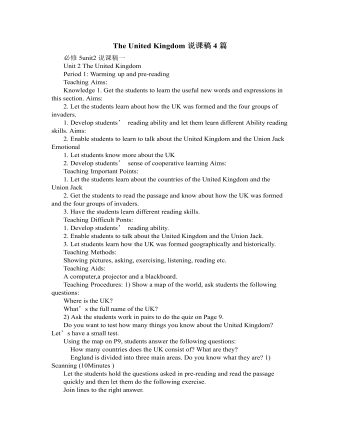
人教版高中英语必修5The United Kingdom说课稿4篇
Teaching Aims:Knowledge 1. Get the students to learn the useful new words and expressions in this section. Aims:2. Let the students learn about how the UK was formed and the four groups of invaders.1. Develop students’ reading ability and let them learn different Ability reading skills. Aims:2. Enable students to learn to talk about the United Kingdom and the Union Jack Emotional 1. Let students know more about the UK2. Develop students’ sense of cooperative learning Aims:Teaching Important Points:1. Let the students learn about the countries of the United Kingdom and the Union Jack2. Get the students to read the passage and know about how the UK was formed and the four groups of invaders.3. Have the students learn different reading skills.Teaching Difficult Ponts:1. Develop students’ reading ability.2. Enable students to talk about the United Kingdom and the Union Jack.3. Let students learn how the UK was formed geographically and historically.Teaching Methods:Showing pictures, asking, exercising, listening, reading etc.Teaching Aids:A computer,a projector and a blackboard.Teaching Procedures: 1) Show a map of the world, ask students the following questions:Where is the UK?What’s the full name of the UK?2) Ask the students work in pairs to do the quiz on Page 9.Do you want to test how many things you know about the United Kingdom? Let’s have a small test.Using the map on P9, students answer the following questions:?How many countries does the UK consist of? What are they??England is divided into three main areas. Do you know what they are? 1) Scanning (10Minutes )Let the students hold the questions asked in pre-reading and read the passagequickly and then let them do the following exercise.Join lines to the right answer.
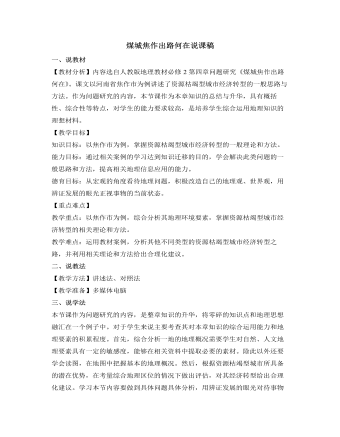
人教版高中地理必修2煤城焦作出路何在说课稿
分析过焦作市的地理概况和产业优势后,就需要针对由于资源枯竭所带来的问题提出合理化的建议。既然是谈经济转型,就应该将话题的范围明确在这一领域内。通过材料3的相关内容,我们了解到焦作市需要在产业结构调整、培育新的优势产业、增强综合竞争力等三个整改方针上下功夫。因而引导学生针对优势与不足提出建议,以三个整改方针为基准,衡量建议的可行性是锻炼学生解决此类问题的有效途径。在此我将教会学生的是解决问题方法而非案例的内容,正所谓“授之以鱼,不如授之以渔”。接下来针对学生的建议和教材资料分析所罗列的10点整改思路,由学生自由发言提出看法,通过教师的指导和学生的讨论,进而确定经济转型建议的具体方案。最后注意将建议与产业优势相对照,看建议是否都是围绕着产业优势而提出的,这样做会加深学生的印象,通过建议和优势的对应关系,将不难找出此类问题的解题思路。
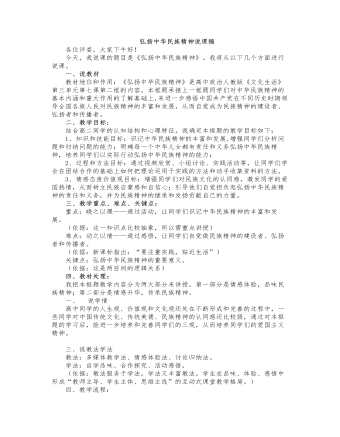
人教版高中政治必修3弘扬中华民族精神说课稿
3、评:以评促行。(6分钟)高中生的年龄特点决定了他们非常重视别人对自己的评价,渴望得到他人的肯定与鼓励。(所以我在班上组织一个活动:让同学们评选出班上“讲文明懂礼貌的文明之星”、“勤思考善创新的学习之星”(先让同学推举大家都认同的4位同学,然后对他们进行投票,投票结果将在下堂课上公布)以此活动来激发同学们用实际行动做民族精神的践行者和传播者。)4、唱:以情激行。(2分钟)在课程内容讲授结完毕后,组织全班同学跟着音乐高唱孙楠的《红旗飘飘》,生化情感,激发同学们的爱国情感。五、课堂拓展(请同学们各展才华:课后让同学们各自准备一个项目以体现民族精神。(项目形式是:或作文、书画;或剪纸、或歌曲小品)……让同学们用实际行动祝愿我们伟大的祖国更加繁荣昌盛!让我们的民族精神代代相传!)
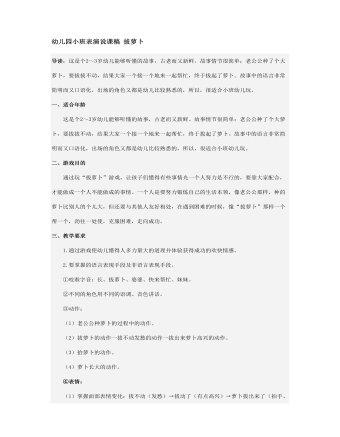
幼儿园小班表演说课稿 拔萝卜
1、让孩子们熟悉故事? 一听:听家长和老师讲,也可以听录音带,有些地方可反复讲、放。 二讲:让孩子们复述故事。 三熟悉:先让孩子们一起一段一段地把故事讲完整,然后以个人或角色小组为单位,配合讲出完整的故事。? 2、示范表演 老师先扮老公公,然后再扮老婆婆,这样一一地把角色的动作和语言给孩子们示范一遍,示范时要注意紧紧抓住各角色的典型特征,如老公公走路和小弟弟、小花狗走路就不一样,但动作应宁简勿繁,以利孩子模仿。 3、自由试演 让小朋友们自由搭配成小组,自由尝试表演各种角色,家长或老师在鼓励的同时作适当的指点。 表演的要点有:各角色动作的典型特征,说话的声音特征,想拔出萝卜的渴望,拔不出萝卜的焦急,盼望帮助的急切和帮忙者的热情,拔出萝卜后的高兴等等。 4、观摩表演 即正式妆扮好分组表演,家长或老师以及不上场的小朋友一起观看。在观摩中可对出场次序、对话、表演等方面进行一定的提示,但应充分鼓励孩子的自由发挥。另外,在表演中加入音乐或音响效果,更能增加游戏气氛。
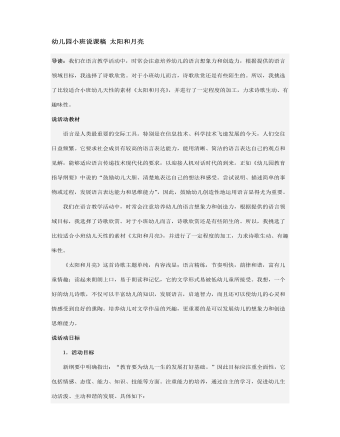
幼儿园小班说课稿 太阳和月亮
语言是人类最重要的交际工具。特别是在信息技术、科学技术飞速发展的今天,人们交往日益频繁。它要求社会成员有较高的语言表达能力,能用清晰、简洁的语言表达自己的观点和见解,能够适应语言传递技术现代化的要求,以迎接人机对话时代的到来。正如《幼儿园教育指导纲要》中说的“鼓励幼儿大胆、清楚地表达自己的想法和感受。尝试说明、描述简单的事物或过程,发展语言表达能力和思维能力”,因此,鼓励幼儿创造性地运用语言显得尤为重要。 我们在语言教学活动中,时常会注意培养幼儿的语言想象力和创造力,根据提供的语言领域目标,我选择了诗歌欣赏。对于小班幼儿而言,诗歌欣赏还是有些陌生的。所以,我挑选了比较适合小班幼儿天性的素材《太阳和月亮》,并进行了一定程度的加工,力求诗歌生动、有趣味性。 《太阳和月亮》这首诗歌主题单纯,内容浅显;语言精练,节奏明快,韵律和谐,富有儿童情趣;读起来朗朗上口,易于朗读和记忆,它的文学形式易被低幼儿童所接受。我想,一个好的幼儿诗歌,不仅可以丰富幼儿的知识,发展语言,启迪智力,而且还可以使幼儿的心灵和情感受到良好的熏陶。培养幼儿对文学作品的兴趣,更重要的是可以发展幼儿的想象力和创造思维能力。
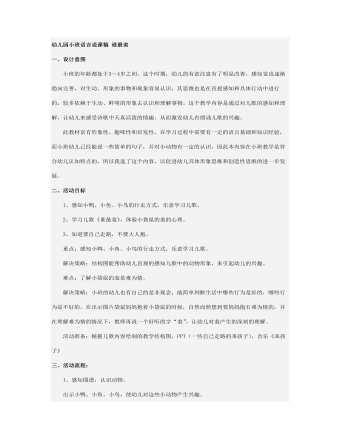
幼儿园小班语言说课稿 谁最羞
1、感知小鸭、小鱼、小鸟的行走方式,乐意学习儿歌。 2、学习儿歌《谁最羞》,体验小袋鼠的羞的心理。 3、知道要自己走路,不要大人抱。 重点:感知小鸭、小鱼、小鸟的行走方式,乐意学习儿歌。 解决策略:结构图能帮助幼儿直观的感知儿歌中的动物形象,来引起幼儿的兴趣。 难点:了解小袋鼠的羞是难为情。 解决策略:小班的幼儿也有自己的是非观念,能简单判断生活中哪些行为是好的,哪些行为是不好的。在出示图片袋鼠妈妈抱着小袋鼠的时候,自然而然想到要妈妈抱石难为情的,并在理解难为情的情况下,教师再说一个好听的字“羞”,让幼儿对羞产生的深刻的理解。 活动准备:根据儿歌内容绘制的教学结构图,PPT(一些自己走路的乖孩子),音乐《乖孩子》
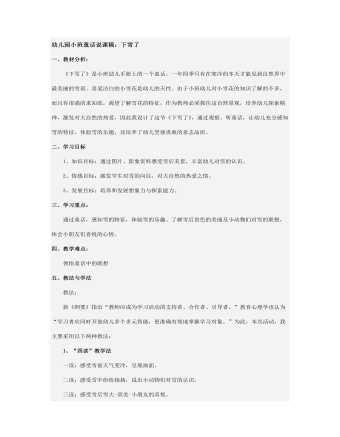
幼儿园小班童话说课稿:下雪了
1、创设情境,激趣导入 先谈话导入“小朋友们现在是什么季节,天气冷吗?”。 事先准备好“雪花”(泡沫削)放在有缝隙的篮子里,篮子放在空调吹风出,打开空调,雪花从天而降,“小朋友们快看,天上飘落了什么?”幼儿一定会兴奋地说道下雪了。“你们喜欢下雪吗?接着播放《雪绒花》音乐,让幼儿回忆下雪时的情景,在柔美的音乐中轻柔飘舞,此时注意不能让幼儿太兴奋以免影响下面活动的发展,而因静静地带他们在座位上飞舞轻柔地使他们安静下来。2、欣赏探索 首先出示《下雪了》图片,引导幼儿欣赏图片,幼儿对新的刺激物很感兴趣,看到图片会自由的说出看到的东西,此时我把一分钟留给幼儿,让他们说说自己看到的。 讲童话部分,我决定运用“四读”法有感情的讲童话。
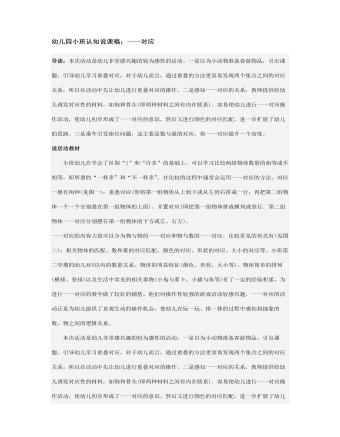
幼儿园小班认知说课稿:一一对应
小班幼儿在学会了区别“l”和“许多”的基础上,可以学习比较两组物体数量的相等或不相等,即所谓的“一样多”和“不一样多”。在比较的过程中通常会运用一一对应的方法。对应一般有两种(见图一):重叠对应(即将第一组物体从上到下或从左到右排成一行,再把第二组物体一个一个分别叠在第一组物体的上面)。并置对应(即把第一组物体排成横列或竖行.第二组物体一一对应分别摆在第一组物体的下方或左、右方)。一一对应的内容大致可以分为物与物的一一对应和物与数的一一对应。比较常见的形式有(见图二):相关物体的匹配、数和量的对应匹配、颜色的对应、形状的对应、大小的对应等。小班第二学期的幼儿对5以内的数量关系、物体的明显特征(颜色、形状、大小等)、物体简单的排列(横排、竖排)以及生活中常见的相关事物(小兔与萝卜,小猫与鱼等)有了一定的经验积累,为进行一一对应的教学做了较好的铺垫。他们对操作性较强的游戏活动较感兴趣,一一对应的活动正是为幼儿提供了直观生动的操作机会,使幼儿在玩一玩、排一排的过程中感知到抽象的数、物之间的逻辑关系。
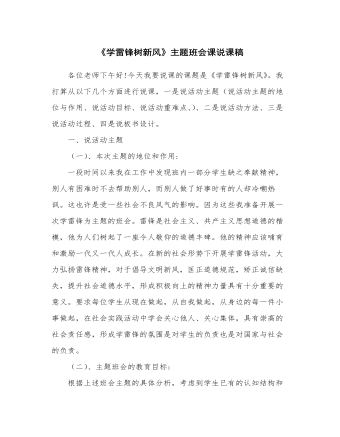
《学雷锋树新风》主题班会课说课稿
2、活动一——雷锋故事会(1)、让同学们展示课前收集的有关雷锋帮助别人的故事。使全体的同学都参与到这个活动中,发挥他们的积极性。(2)、为了丰富教育资源我在此处为学生准备了《可敬的“傻子”》、《雨夜送大嫂》、《人民的勤务员》三个故事,进行补允让学生更加全面的了解雷锋精神。设计此活动的目的是陶冶学生情操,让学生更加深入的了解勤俭朴素、助人为乐、全心全意为人民服务雷锋形象。3、活动二一一读《雷锋日记》让学生读雷锋给一位陌生老人送完手套后写的日记。重点理解“一路上,我的手虽冻得像针扎一样,心中却有一种说不出的愉快。”这一句话。让学生谈谈自己的感受。此活动的目的是让学生了解雷锋的内心世界,理解雷锋精神的实质,全心合意为人民服务。
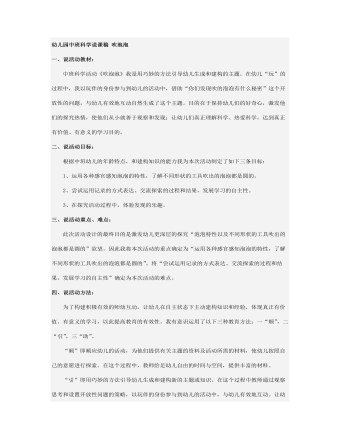
幼儿园中班科学说课稿 吹泡泡
为了构建积极有效的师幼互动,让幼儿在自主状态下主动建构知识和经验,体现真正有价值、有意义的学习,以此提高教育的有效性。我有意识运用了以下三种教育方法:一“顺”,二“引”,三“助”。 “顺”即顺应幼儿的活动,为他们提供有关主题的资料及活动所需的材料,使幼儿按照自己的意愿进行探索。在这个过程中,教师给足幼儿自由的时间与空间,提供丰富的材料。 “引”即用巧妙的方法引导幼儿生成和建构新的主题或知识。在这个过程中教师通过观察思考和设置开放性问题的策略,以玩伴的身份参与到幼儿的活动中,与幼儿有效地互动。让幼儿在“玩”中学,在学中“玩”。 “助”即教师在适当的时候“助”幼儿一臂之力,对幼儿进行点拔,借助当时的情景、材料,直接地提出主题,把幼儿的学习兴趣推向深入。
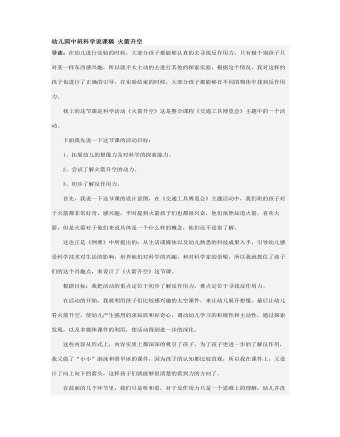
幼儿园中班科学说课稿 火箭升空
在幼儿进行实验的时候,大部分孩子都能够认真的去寻找反作用力,只有极个别孩子只对某一样东西感兴趣,所以就不太主动的去进行其他的探索实验,根据这个情况,我对这样的孩子也进行了正确的引导,在实验结束的时候,大部分孩子都能够在不同的物体中找到反作用力。 我上的这节课是科学活动《火箭升空》这是整合课程《交通工具博览会》主题中的一个活动。 下面我先说一下这节课的活动目标: 1、拓展幼儿的想像力及对科学的探索能力。 2、尝试了解火箭升空的动力。 3、初步了解反作用力。 首先,我说一下这节课的设计意图,在《交通工具博览会》主题活动中,我们班的孩子对于火箭都非常好奇,感兴趣,平时提到火箭孩子们也都很兴奋,他们虽然知道火箭,喜欢火箭,但是火箭对于他们来说具体是一个什么样的概念,他们还不是很了解。
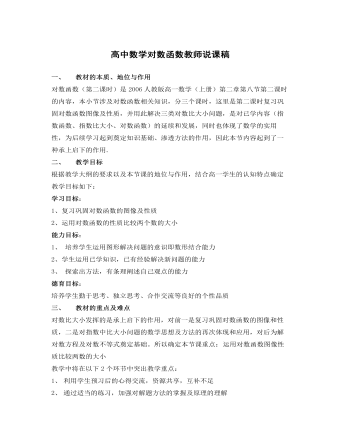
高中数学对数函数教师说课稿
一、 教学目标根据教学大纲的要求以及本节课的地位与作用,结合高一学生的认知特点确定教学目标如下:学习目标:1、复习巩固对数函数的图像及性质2、运用对数函数的性质比较两个数的大小能力目标:1、 培养学生运用图形解决问题的意识即数形结合能力2、学生运用已学知识,已有经验解决新问题的能力3、 探索出方法,有条理阐述自己观点的能力
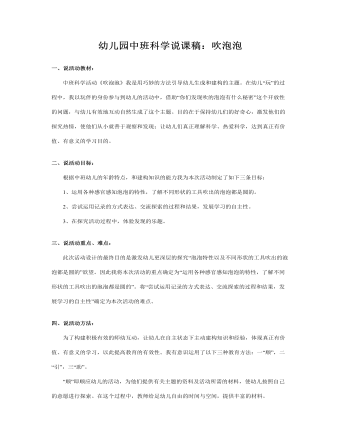
幼儿园中班科学说课稿:吹泡泡
二、说活动目标: 根据中班幼儿的年龄特点,和建构知识的能力我为本次活动制定了如下三条目标:1、运用各种感官感知泡泡的特性,了解不同形状的工具吹出的泡泡都是圆的。2、尝试运用记录的方式表达、交流探索的过程和结果,发展学习的自主性。3、在探究活动过程中,体验发现的乐趣。三、说活动重点、难点: 此次活动设计的最终目的是激发幼儿更深层的探究“泡泡特性以及不同形状的工具吹出的泡泡都是圆的”欲望。因此我将本次活动的重点确定为“运用各种感官感知泡泡的特性,了解不同形状的工具吹出的泡泡都是圆的”。将“尝试运用记录的方式表达、交流探索的过程和结果,发展学习的自主性”确定为本次活动的难点。
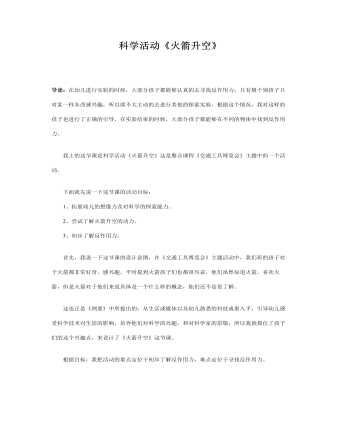
幼儿园中班科学说课稿:火箭升空
我上的这节课是科学活动《火箭升空》这是整合课程《交通工具博览会》主题中的一个活动。 下面我先说一下这节课的活动目标:1、拓展幼儿的想像力及对科学的探索能力。2、尝试了解火箭升空的动力。3、初步了解反作用力。 首先,我说一下这节课的设计意图,在《交通工具博览会》主题活动中,我们班的孩子对于火箭都非常好奇,感兴趣,平时提到火箭孩子们也都很兴奋,他们虽然知道火箭,喜欢火箭,但是火箭对于他们来说具体是一个什么样的概念,他们还不是很了解。 这也正是《纲要》中所提出的:从生活或媒体以及幼儿熟悉的科技成果入手,引导幼儿感受科学技术对生活的影响,培养他们对科学的兴趣,和对科学家的崇敬,所以我就抓住了孩子们的这个兴趣点,来设计了《火箭升空》这节课。
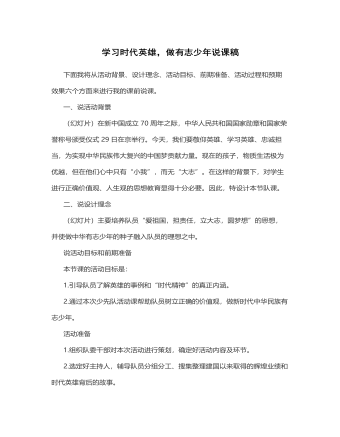
学习时代英雄,做有志少年说课稿
一、说活动背景(幻灯片)在新中国成立70周年之际,中华人民共和国国家勋章和国家荣誉称号颁受仪式29日在京举行。今天,我们要敬仰英雄、学习英雄、忠诚担当,为实现中华民族伟大复兴的中国梦贡献力量。现在的孩子,物质生活极为优越,但在他们心中只有“小我”,而无“大志”。在这样的背景下,对学生进行正确价值观、人生观的思想教育显得十分必要。因此,特设计本节队课。二、说设计理念(幻灯片)主要培养队员“爱祖国,担责任,立大志,圆梦想”的思想,并使做中华有志少年的种子融入队员的理想之中。说活动目标和前期准备本节课的活动目标是:1.引导队员了解英雄的事例和“时代精神”的真正内涵。2.通过本次少先队活动课帮助队员树立正确的价值观,做新时代中华民族有志少年。
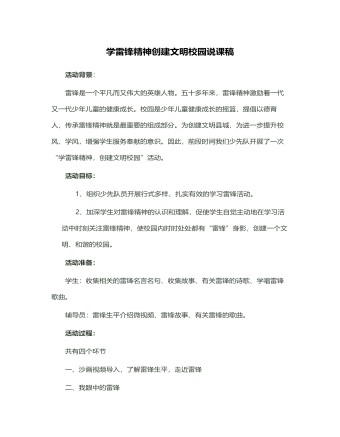
学雷锋精神,创建文明校园说课稿
雷锋精神是什么?这一环节是让学生用简单的词语或句子概括。通过这一活动,让学生概括出雷锋精神的内涵:像无私奉献、乐于助人、为人民服务、勤俭节约、尊老爱幼、勤奋好学、干一行爱一行、言行一致等等都是雷锋精神的体现。我们少年儿童是中国的未来和希望,雷锋精神的发扬和光大,创建文明校园的任务就落在他们的肩上,所以在这里我还设计了为发扬雷锋精神,创建文明校园“我该怎么做”这样的问题,目的就是让他们一起行动起来,学雷锋做好事,并制作了“荣誉”旗,奖励身边的好人好事。活动延伸:这里我设计了一个角色游戏活动——我要义卖献爱心,这个游戏学生们表现得非常积极,他们收集了自己不要的小文具或小玩具,将他们拿到集市上去卖,卖东西获得的钱,捐给王奶奶的孙女,因为王奶奶的孙女生病了,无钱治病。我觉得这个游戏使学生们懂得,一个人只要有爱心,只要愿意去帮助别人,无论什么方式都行,而且在游戏活动中孩子们体会到了帮助别人是一件多么多么快乐的事呀。



